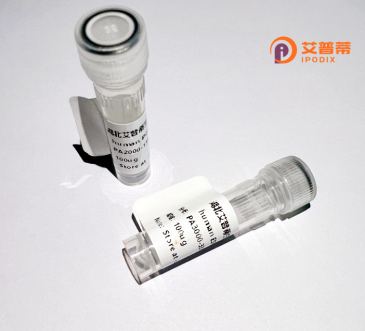
| 纯度 | >90%SDS-PAGE. |
| 种属 | Human |
| 靶点 | CYP4F3 |
| Uniprot No | Q08477 |
| 内毒素 | < 0.01EU/μg |
| 表达宿主 | E.coli |
| 表达区间 | 1-520aa |
| 氨基酸序列 | MPQLSLSSLGLWPMAASPWLLLLLVGASWLLARILAWTYTFYDNCCRLRCFPQPPKRNWFLGHLGLIHSSEEGLLYTQSLACTFGDMCCWWVGPWHAIVRIFHPTYIKPVLFAPAAIVPKDKVFYSFLKPWLGDGLLLSAGEKWSRHRRMLTPAFHFNILKPYMKIFNESVNIMHAKWQLLASEGSARLDMFEHISLMTLDSLQKCVFSFDSHCQEKPSEYIAAILELSALVTKRHQQILLYIDFLYYLTPDGQRFRRACRLVHDFTDAVIQERRRTLPSQGVDDFLQAKAKSKTLDFIDVLLLSKDEDGKKLSDEDIRAEADTFMFEGHDTTASGLSWVLYHLAKHPEYQERCRQEVQELLKDREPKEIEWDDLAQLPFLTMCIKESLRLHPPVPAVSRCCTQDIVLPDGRVIPKGIICLISVFGTHHNPAVWPDPEVYDPFRFDPKNIKERSPLAFIPFSAGPRNCIGQAFAMAEMKVVLGLTLLRFRVLPDHTEPRRKPELVLRAEGGLWLRVEPLS |
| 分子量 | 59.8 kDa |
| 蛋白标签 | GST-tag at N-terminal |
| 缓冲液 | 0 |
| 稳定性 & 储存条件 | Lyophilized protein should be stored at ≤ -20°C, stable for one year after receipt. Reconstituted protein solution can be stored at 2-8°C for 2-7 days. Aliquots of reconstituted samples are stable at ≤ -20°C for 3 months. |
| 复溶 | Always centrifuge tubes before opening.Do not mix by vortex or pipetting. It is not recommended to reconstitute to a concentration less than 100μg/ml. Dissolve the lyophilized protein in distilled water. Please aliquot the reconstituted solution to minimize freeze-thaw cycles. |
以下是关于重组人CYP4F3蛋白的3篇参考文献及其简要摘要:
---
1. **文献名称**:*"Expression and functional characterization of recombinant human CYP4F3 in insect cells"*
**作者**:Hoch U, et al.
**摘要**:该研究利用杆状病毒-昆虫细胞系统成功表达了重组人CYP4F3蛋白,并证实其催化白三烯B4(LTB4)的ω-羟基化活性,揭示了CYP4F3在炎症相关脂质代谢中的关键作用。
2. **文献名称**:*"Purification and enzymatic properties of human CYP4F3 isoforms: Differential metabolism of leukotrienes"*
**作者**:Kikuta Y, et al.
**摘要**:通过大肠杆菌表达系统纯化重组CYP4F3蛋白,比较其与CYP4F家族其他亚型(如CYP4F2)的酶动力学差异,发现CYP4F3对LTB4的催化效率显著高于其他底物,支持其作为炎症调节因子的功能。
3. **文献名称**:*"Role of CYP4F3 in vitamin E metabolism: Insights from recombinant expression studies"*
**作者**:Sontag TJ, et al.
**摘要**:在HEK293细胞中重组表达CYP4F3蛋白,分析其对维生素E代谢物的羟化能力,提出CYP4F3可能通过调控维生素E代谢影响氧化应激相关疾病进程。
---
**说明**:
CYP4F3是细胞色素P450家族成员,主要参与脂质介质(如白三烯、维生素E)的代谢。上述文献聚焦于其重组表达方法(昆虫细胞、大肠杆菌、HEK293系统)、酶活性及生理病理意义。实际应用中建议通过PubMed或Web of Science进一步筛选领域内最新研究。
Human CYP4F3 is a member of the cytochrome P450 superfamily, a group of enzymes critical in the oxidation of endogenous and exogenous compounds. Specifically, CYP4F3 is involved in metabolizing bioactive lipids, including arachidonic acid derivatives such as leukotriene B4 (LTB4) and hydroxyeicosatetraenoic acids (HETEs). This enzyme plays a dual role, acting as a regulator of inflammatory responses by inactivating pro-inflammatory mediators and participating in maintaining cellular lipid homeostasis. CYP4F3 exists as two splice variants (CYP4F3A and CYP4F3B) with distinct tissue distributions: CYP4F3A is predominantly expressed in neutrophils, while CYP4F3B localizes to the liver.
Recombinant human CYP4F3 protein is generated using heterologous expression systems (e.g., Escherichia coli or insect cells) to enable functional and structural studies. Its production has facilitated research into substrate specificity, catalytic mechanisms, and interactions with redox partners. Additionally, recombinant CYP4F3 serves as a tool for drug development, particularly in assessing drug metabolism and toxicity, as well as exploring its role in diseases linked to lipid dysregulation, such as cancer, inflammation, and metabolic disorders. Understanding its enzymatic activity offers potential therapeutic insights for modulating inflammatory pathways or lipid-related pathologies.
×